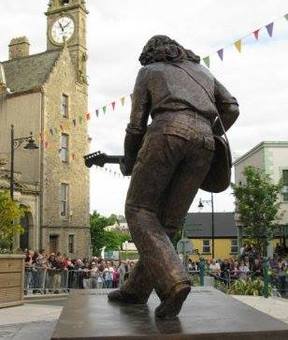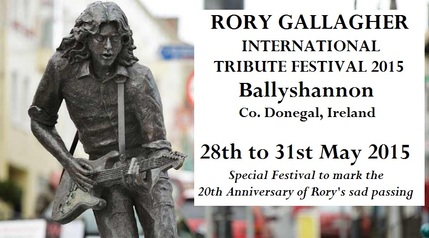
It was November 1977. Guitarist Rory Gallagher and his band members – bassist Gerry McAvoy, keyboardist Lou Martin and drummer Rod de’Ath – were capping off a 6-month world tour with dates in Japan before coming to San Francisco to begin
work on a new studio album. Gallagher had signed a deal with Chrysalis Records and would be working with hotshot producer Elliot Mazer, whose clients included Neil Young, Janis Joplin, Gordon Lightfoot and The Band. The songs were recorded quickly, but the sessions were dogged with tension and Rory’s belief that the mixing was too complicated. He was also becoming restless and wanted to get back to roots, playing basic rock and blues as he had done in the power trio, Taste.
As the album tracks were being mixed, Rory saw The Sex Pistols perform at the Winterland Ballroom and was struck by the band’s raw energy and power, remarking, “It was as close to Eddie Cochran as you’re going to get.” The experience pushed him further away from the recording at hand and by the end of January 1978, the project was aborted and Rory broke up the band. The recordings remained shelved for more than 30 years, finally coming to light in May 2011 Notes From San Francisco, a two-CD set featuring the original studio tracks studded with three bonus cuts and a fantastic remix courtesy of Rory’s nephew Daniel Gallagher. The second disc appends Notes, with a fiery previously unreleased live set recorded in 1979 at San Francisco’s Old Waldorf, with a three-piece unit consisting of Gallagher, McAvoy and new drummer Ted McKenna.
Rock Cellar Magazine spoke with Rory’s brother Dónal, who served as Rory’s long-time manager and has since handled his late brother’s affairs.
DÓNAL GALLAGHER: Very positive – they had Warner Brothers distribution at that time and that company had also tried to sign Rory separately. The principals of Chrysalis seemed to enjoy having a reason to visit
the studios. They genuinely wanted to see Rory get his deserved credit and attention from the U.S. world of radio and charts and align record sales to Rory’s concert drawing power.
RCM: The album was recorded after coming off the road and is the last studio recording by Rory with Lou Martin and Rod de’Ath. Was it a difficult record to make ?
DG: It didn’t seem so at that time, though with hindsight, the physical strain of recording off the back of a year long World Tour – we came to the West Coast from Japan – without a break. Actually, having the same bed for several weeks in San Francisco seemed like a vacation.
RCM: Elliot Mazer had a pretty good track record prior to this. What did you think when you heard the mix ?
DG: I thought they were terrific and sounded very different. I had difficulty hearing what Rory was unhappy with. To be fair to Elliot, Rory probably had really wished to work with other U.S.-based musicians
for this experience but felt a loyalty to his band. RCM: Was there discussion about a possible radio single or follow-up tour? DG: At that time, there was no problem booking out a Rory tour – it only took one call to our then agents, I.C.M. As far as a single and airplay, the Chrysalis execs seemed blown [away]
by the acoustic version of Wheels, Within, Wheels. I felt it could be either Overnight Bag or Cruise on Out.
RCM: Your son, Daniel, produced this and did a great job. How do you assess the differences in the original mixes and these ?
DG: The tracks are more opened up – there is a lot more space for the instrumentation. Elliot’s mixes would have been very much to Rory’s desire (so it’s difficult to say how the mixes would have been if Elliot had had a free hand). On reflection, I believe Mazer had done his best by my brother with the original recordings but was in a no-win position by the end.
RCM: Can we blame the Sex Pistols for the long delay in this release ?
DG: Not really. I would say that Rory in his “heart of hearts” was already troubled with aspects of the mixing, his band; in reality, it was not fulfilling his ambitions of a U.S. album. However, the Sex Pistols chaotic gig probably demonstrated to my brother that “when in a hole, stop digging.”
RCM: Does the track sequencing match the original recording ?
DG: Though it’s close, not entirely. Elliot and Dan had much debate between them on the order of tracks. But the original would have been based on two sides of vinyl, and the record would not have contained all of the
recorded tracks.
RCM: The electric violin on Mississippi Sheiks by Joe O’Donnell is fantastic. How did he come to play on the track ?
DG: Rory had been a guest on Joe O’Donnell’s Gaodhol’sVision album in 1977. It’s an eclectic instrumental
album, which musically traced the roots of Celtic music back to the time of the Pharaohs, in Egypt and a banished wandering tribe led by Gaodhal (Geal). It’s super stuff.
RCM: There are two versions of Wheels Within Wheels. Did Rory often record more than one version of the same tune before deciding on what made it to record ?
DG: Not that I recall, although he later did an acoustic version of Secret Agent for television.
RCM: Cruise On Out sounds like a live track. How free were Lou, Gerry and Rod to play what they wanted in the studio ?
DG: Yes, it’s a favorite. Rory told me it was one for Elvis Presley. Rory would always have the arrangement of a song worked out; being a multi-instrumentalist he knew what he wanted to hear. However, he liked the music to flow, so, in that respect the guys could provide input.
RCM: The horns on Brute Force & Ignorance give it a Mexican vibe. Whose idea was it to add them? Were the parts charted out ?
DG: Again, Rory being a sax player himself would have figured out the charts. Martin Fierro was Mexican and Rory wanted to bring that Tequila vibe to the track, as the song is about rock and roll touring turmoil. Rory must have had a premonition of the Sex Pistols gig !
RCM: After these sessions Rory broke up part of the band and returned to a 3-piece. What did Ted McKenna bring to the table that Rory liked ?
DG: To my thinking, Rory was seeking a new drummer to lay down the beat more, stay on it, sync in more with the bassist, which allowed Rory more space to layer his guitar technique over the rhythm section. RCM: Van Morrison was in attendance at the live Waldorf gig. Were he and Rory friends ?
DG: Yes, Rory and Van became good friends, in particular, when Van decided to live in London. We would see him socially – they both had interacted with the places and faces of the Belfast music scene and musically had much in common. Van would come to my house a lot back then and Rory would hookup with us there.
Van had invited my brother to play on his album Period of Transition, but a lack of communication at the session saw Rory leave after many hours of having to wait around. Later at Van’s request, I put them together as Van wished to form a grouping to make a “blues” album. Parallel to this, the Irish broadcast company,
RTÉ, was making a television series titled The Sessions and had asked for one featuring Rory. So the deal would be they would have the broadcast but we could come away with the multi-tracks and videotape. Rory had then recently played a great charity gig, in Edinburgh, put together by Jack Bruce (bass), which had
Charlie Watts (drums), Ian Stewart (keys), Dick Heckstall-Smith and a brass line-up. To that [lineup] Van wanted to add Brian Auger. However, at a lead-up meeting Van’ s humor just changed: He left and the whole session fell apart. Even though RTÉ still wanted to make the show without Morrison, the whole experience depressed my brother and he scrapped the idea.
See more at:
http://www.rockcellarmagazine.com/2011/07/19/rory-gallagher-his-enduring-legacy/#sthash.9Q9bI2Ys.dpbs

 RSS Feed
RSS Feed